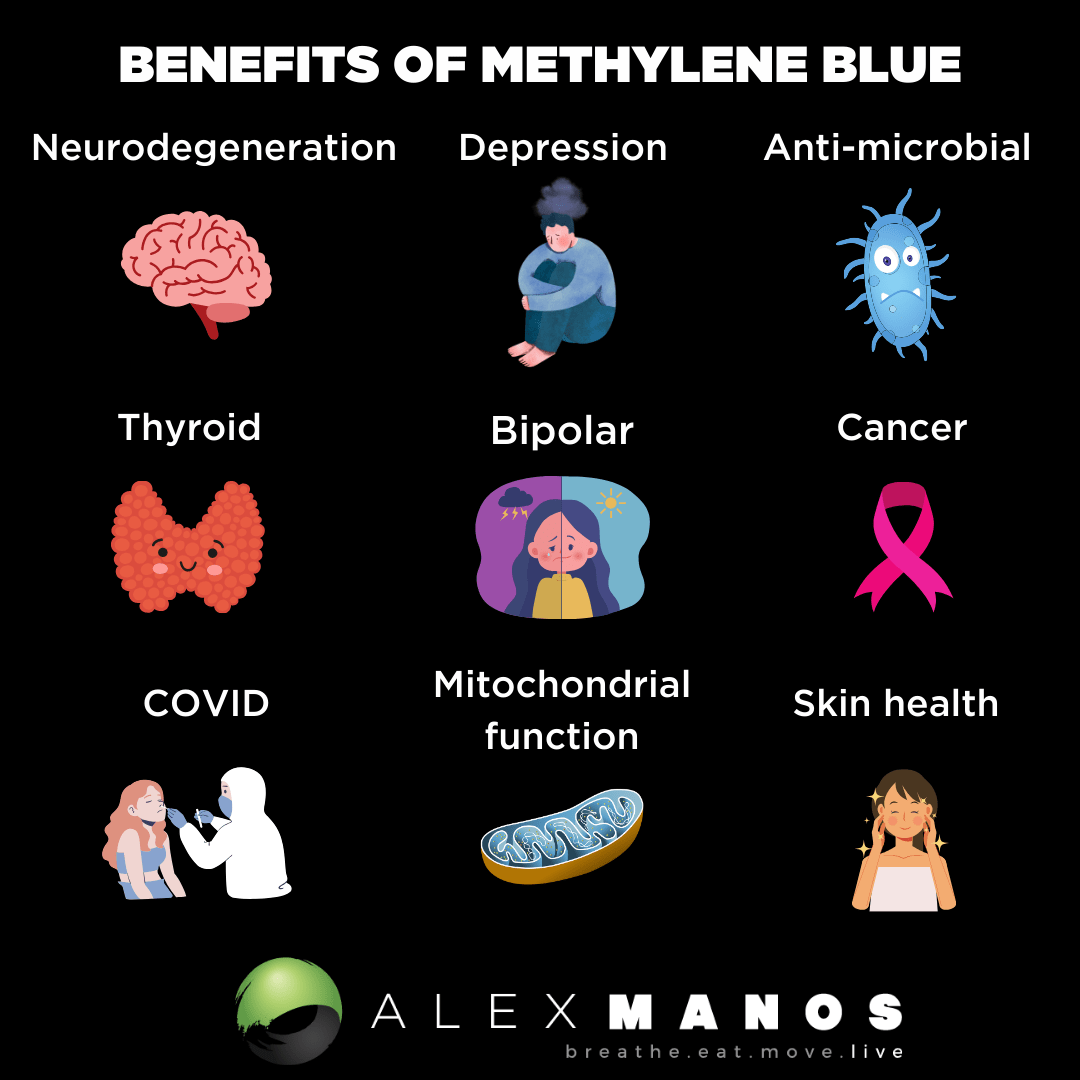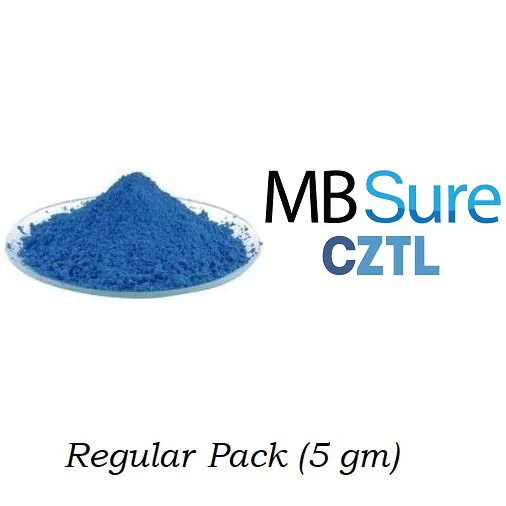Welcome to my blog “Benefits Of Methylene Blue”.
You might also like to read:
What Is Methylene Blue (MB)?
Methylene blue (MB) is considered to be the first synthetic medication ever used in humans (1).
It is an FDA-approved medication which has been used as an effective agent in malaria treatment, methemoglobinemia, and cyanide poisoning (8)
10 Benefits Of Methylene Blue
The benefits of methylene blue include:
- Therapy for Alzheimer’s disease.
- Improved mitochondrial function
- Improved mood.
- Improved brain function.
- COVID 19.
- Improved thyroid health.
- Antiviral antibacterial, anti fungal.
- Anti-aging.
- Skin health.
- Bi-polar.
Mitochondrial Function
Low-dose MB stimulates mitochondrial respiration by donating electrons to the electron transport chain.
It’s important we start by discussing the benefits of methylene blue in mitochondrial function as this is a likely mechanism for its numerous benefits.
Its role in the mitochondria has elicited much of its renewed interest in recent years. Methylene Blue can reroute electrons in the mitochondrial electron transfer chain directly from NADH to cytochrome c, increasing the activity of complex IV and effectively promoting mitochondrial activity while mitigating oxidative stress. Mitochondrial dysfunction has been identified as a seemingly unifying pathological phenomenon across a wide range of neurodegenerative disorders, which thus positions methylene blue as a promising therapeutic.
Methylene Blue And Alzheimer’s disease
Methylene Blue is currently being studied as potential therapy for mild cognitive impairment Alzheimer’s and Parkinson’sdisease, and other neurodegenerative disorders. All sharing a common problem with mitochondrial function.
Mitochondrial dysfunction is being discussed as the “missing link” between aging and Alzheimer’s disease. In the early stages of Alzheimer’s disease progression, elevated mitochondria-derived oxidative stress has been reported. Mitochondria with reduced size and impaired movement were also observed in the Alzheimer’s disease.
Low-dose treatment with methylene blue can reduce ROS production, which could be beneficial to Alzheimer’s disease patients.
Alzheimer’s disease is linked to an accumulation of the protein tau. Methylene Blue has been shown in clinical trials to inhibit tau formation. It is being considered a drug for the treatment of Alzheimer’s disease. This is likely due to improving electron flow, ATP production, absorbing more external photon (light) absorption, and preventing excessive free radical damage or biophoton emission from stressed cells.
Methylene Blue supports brain cell respiration by raising oxygen levels throughout the body. As well as providing electrons to the electron transport chain in the mitochondria. The exact process is used to generate mitochondrial ATP when you eat.
Methylene blue has been tested in a human clinical trial in which patients with mild to moderate Alzheimer’s disease showed both cognitive and cerebral blood flow improvements after methylene blue treatment.
Depression
There are also benefits of methylene blue in depression.
A low dose of Methylene Blue has an antidepressant effect because it acts as a monoamine oxidase (MAO) inhibitor. Monoamine oxidases are enzymes that remove the neurotransmitters norepinephrine, serotonin, and dopamine from the brain. Inhibition of MAO prevents monoamine neurotransmitters’ breakdown, which directly leads to an increased level of these neurotransmitters.
Nootropic
Nootropics are natural, semi-synthetic and synthetic substances that improve cognitive functions.
Methylene blue has been gaining increase attention for its potential role as a nootropic. This is partly based on the concept of cognitive enhancement via mitochondrial modulation, which has also been investigated increasingly in recent years.
The idea is that by improving mitochondrial function and oxidative defenses, neurons can function with improved efficiency and maintain proper health, improving overall function (source).
COVID-19
This molecule was found to inhibit the interaction of COVID19 virus and target cells in dose dependent manner. It was also found to inhibit interaction of viron with host cells, by inhibiting interaction of SARS CoV2 spike protein and ACE inhibitor receptor interactions. (3)
Thyroid Health
Surprisingly, blood thyroxine levels increased consistently in rats after Methylene Blue treatment (4)
Methylene Blue in an animal study was shown to increase T4 levels of thyroxine which might be indirectly connected to the same animal study review of decreased prolactin levels after stimulating a stress response with the administration of estrogen.
Anti-microbial
Another one of the benefits of methylene blue that will be of great interested to my readers is that it has unique gut healing abilities by displacing Candida albicans infections, which, if not resolved, could lead to colonisation and severe health issues.
Researchers have also showed that methylene blue is effective against two non-albicans species as well (source).
Methylene Blue supports not only fungal issues but also bacterial infections.
In the early 1930s, the first observations of MB ability to inactivate bacteriophages and viruses were reported (source).
In fact, research over the last 3 years has discussed the repurposing of methylene blue in the management of COVID-19 (source).
Low Methylene Blue doses combined with specific light (especially UV) can effectively combat viruses.
Anti-Aging
According to the “free radicals theory of aging”, cell and tissue aging are the result of the accumulation of free radicals. In human cells, reactive oxygen species (free radicals) are mainly produced in mitochondria.
In aging, we see declines in mitochondrial mass, respiration capacity, and respiration efficiency.
Mitochondrial dysfunction leads to decreased energy production and an increase in free radical production, which further damages the mitochondria. This creates a vicious cycle which ultimately leads to accelerated aging.
Methylene blue’s antioxidant properties improve mitochondrial function and break this cycle, which makes it a great candidate as an anti-aging drug. (source)
Skin Health
Methylene Blue at a low dose was shown to stimulate improvements and increased protein activation in collagen and elastin production.
Bipolar Disorder
In psychiatry, methylene blue has been used for over a century.
It was tried successfully in the treatment of psychotic and mood disorders and as a memory enhancer in fear-extinction training. Particularly promising results have been obtained in both short- and long-term treatment of bipolar disorder. In these studies, methylene blue produced an antidepressant and anxiolytic effect without risk of a switch into mania. Long-term use of methylene blue in bipolar disorder led to a better stabilization and a reduction in residual symptoms of the illness. It is usually well tolerated, but caution is needed in the light of its inhibitory effect on monoamine oxidase A. (5)
Cancer
Oncology seems to be a promising area for methylene blue use thanks to its pronounced photosensitising action that results in the disruption of disease causing cells under the influence of light. This effect occurs because of the phenothiazine chromophore. It absorbs the light in the range of wavelengths from 630 to 680 nm, which leads to the generation of reactive oxygen species and the death of the cell.
Furthermore, methylene blue selectively accumulates in cancer cells. As a result researchers have suggested that the benefits of methylene blue may include its use in photodynamic anticancer therapy and a systematic review (source) concluded:
The results of the systematic review support the suggestions that photodynamic therapy with methylene blue helps against different types of cancer, including colorectal tumor, carcinoma, and melanoma.
There is accumulating evidence providing a proof of concept that enhancement of mitochondrial oxidative phosphorylation via alternative mitochondrial electron transfer may offer protective action against neurodegenerative diseases and inhibit cancers proliferation (6)
Memory
Animal studies have shown that a single low dose of Methylene Blue enhances long-term contextual memory.
Frequently Asked Questions
When should I Take Methylene Blue?
Methylene blue should be taken in the morning to compliment the natural morning dominant red light spectrum. There is no hard rule to follow but from my personal experience, experience with clients, and speaking with Dr. Scott Sherr morning and mid-morning times are preferential.
Recommended Dosage To Achieve Benefits Of Methylene Blue
There is no true recommended dose for Methylene Blue. David Tomen from Nootropic Expert recommends starting with the lowest dose of 0.5 mg/kg and see how you react.
Methylene blue is a safe drug when used in doses of < 2 mg/kg (source).
In another study it was demonstrated that doses between 0.5–4 mg/kg were effective to stimulate mitochondrial respiration in vivo, and safe in animals and humans (source)
Tomen also explains how Methylene Blue is water-soluble so you don’t need to take it with a meal, or healthy fat like some nootropics.
References
- From Mitochondrial Function to Neuroprotection-an Emerging Role for MB (click here)
- The Potentials of MB as an Anti-Aging Drug (click here)
- MB in management of COVID19 (click here)
- MB as an endocrine modulator: interactions with thyroid hormones (click here)
- MB in the Treatment of Neuropsychiatric Disorders (click here)
- Alternative mitochondrial electron transfer for the treatment of neurodegenerative diseases and cancers: MB connects the dots (click here)
- Protection against neurodegeneration with low-dose MB and near-infrared light (click here)
- Mitochondria as a target for neuroprotection: role of MB and photobiomodulation (click here)
Alex is a certified Functional Medicine Practitioner (IFMCP) and has a MSc in Personalised Nutrition. He is also a breathwork facilitator with a background in personal training and massage therapy. He also runs The Resiliency Program - a 24 week program aimed at building physical, mental, emotional, and spiritual resilience.




